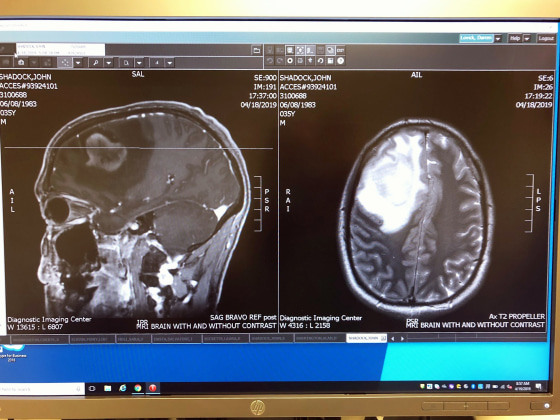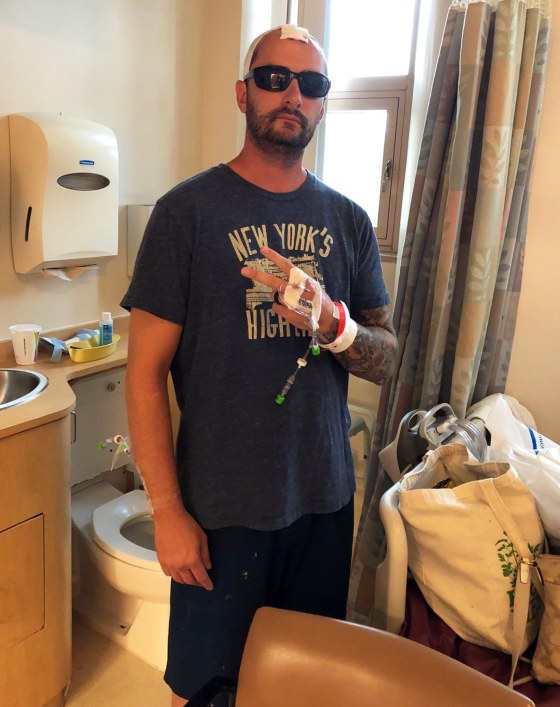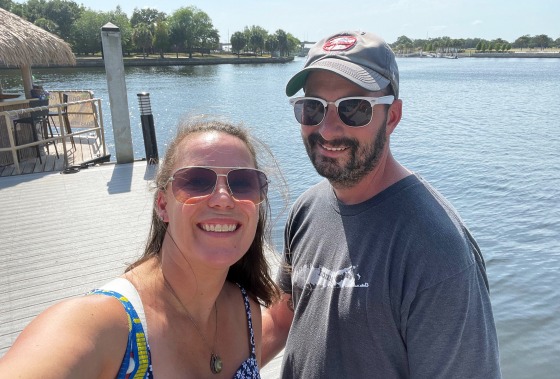
John and Ali Shadock were just a few years into their marriage — a romance that started at an Ikea furniture store — when he suddenly began experiencing severe headaches.
He was 35 and healthy, and the couple had been enjoying adventures — hiking, traveling and road trips with their dogs.
So a health problem, let alone a life-threatening crisis, seemed far-fetched.

Still, the headaches, which started out of the blue in the spring of 2019 and wouldn’t go away, were concerning.
“I thought they were migraines,” John Shadock, who is now 41, tells TODAY.com.
“It was excruciating beyond painful,” Ali Shadock, 48, recalls about her husband’s experience.
U.S. & World
“In the middle of the night, he’d be like, ‘Can you get me an ice pack?’ and I’d put an ice pack on his head. … We thought, this isn’t right. We have to go to the doctor.”
Their primary care physician referred John Shadock for a brain scan in April 2019. At the imaging center in Kansas City, Missouri, where the couple lived at the time, they watched other people leave right after their scans, but they were asked to stay.
Feeling out of the loop? We'll catch you up on the Chicago news you need to know. Sign up for the weekly Chicago Catch-Up newsletter.
“'Mr. and Mrs. Shadock, the doctor needs to talk to you in the back,’” Ali Shadock recalls the staff saying.
“It was a younger doctor, and he looked like he’s about to cry. He said, ‘There’s something in your head that looks like a big tumor. You have to leave here and immediately go to the emergency room.’”

Five days later, John Shadock was on an operating table, undergoing his first brain surgery. A biopsy of the tumor confirmed it was glioblastoma, “one of the most complex, deadly and treatment-resistant cancers,” the National Brain Tumor Society warns. It's so aggressive that it's been called "the terminator."
The average length of survival is eight months, but John Shadock is doing well more than five years after his diagnosis.
“His survival is pretty extraordinary,” Dr. Peter Forsyth, chairman of the neuro-oncology program at Moffitt Cancer Center in Tampa, Florida, where Shadock is being treated, tells TODAY.com.
“There’s something special about him or his brain or his tumor. … John shows what’s possible. That’s very, very important, uplifting.”
'Instantly, your life is changed'
John and Ali Shadock met and fell in love when they both worked at an Ikea on Long Island, New York.
They married on July 11, 2014, choosing the date in part because it would be easy to remember — 7/11. After their wedding, they stopped at a 7-Eleven convenience store to take a photo, and it’s become an annual tradition on their anniversary.

“We were living life, having so much fun,” she says. “Then instantly, your life is changed.”
After John Shadock’s first brain surgery in April 2019, the couple was told he had six months to a year to live.
“It was terrible,” John Shadock recalls. “It’s heartbreaking.”
What causes glioblastoma?
Glioblastoma can strike anyone, at any age, though the disease is more common in older people, Forsyth says.
Doctors don’t know what triggers it — there isn't a clear environmental or genetic cause, he notes.
July 17, 2024, marks Glioblastoma Awareness Day. Almost 15,000 Americans will be diagnosed with the aggressive cancer this year. There is no cure. Persistent headaches are among the most common glioblastoma symptoms.
Standard treatment begins with surgery to remove as much of the tumor as possible, which is supremely difficult because the cancer grows tentacles into the brain.
John Shadock was awake for his second brain surgery in July 2019, so that he could respond to questions during the procedure. That allowed doctors to map critical areas of his brain that control speech and movement, and remove more of the tumor without causing damage.
Radiation and chemotherapy are next, but this only extends life for a few months for most patients, according to the National Brain Tumor Society.
Clinical trials to test promising new therapies for glioblastoma can be key.

Long-term survivor of glioblastoma
John Shadock got into a clinical trial at Dana-Farber Cancer Institute in Boston, and then at Moffitt Cancer Center. The couple moved to Tampa, Florida, so he could be treated there.
The trials involved two different immunotherapy approaches — including one where a slightly modified polio virus was infused into his brain tumor to act like a red flag for his immune system.
Glioblastoma cells stay quiet and unnoticed, evading the body’s defenses. But when the polio virus targets them, it leads to inflammation, which “starts a little fire that attracts all your immune cells,” Forsyth says. “The virus is a way to draw attention of the body to that problem.”
John Shadock did well with the clinical trials, and his immune system is fighting the cancer, attacking cells that grow back, the doctor notes. He believes there may be something special about Shadock’s body that’s helping him live. Perhaps it’s like soil that’s hostile to the seed (the tumor), and not allowing it to grow.
John Shadock was also in good shape and active when diagnosed, which helps, and he has good family support, which is “super important,” Forsyth adds.
John Shadock credits one thing for helping him live: “Ali’s positive attitude, without a doubt,” he says about his wife. “She’s amazing.”

'It's not a death sentence'
Ali Shadock remembers visiting the striking glass Thorncrown Chapel in Arkansas after her husband’s diagnosis and thinking, “Give me something we can handle and work with.”
“We’re going to figure it out,” she says about her mindset. “What’s the next step? What can we do? What are our options? There are always options. There’s always some kind of hope. There’s always a different way to think about it or go about it.”
She’s never missed any of his doctor’s appointments, and makes it a point to celebrate every bit of progress. Being proactive and trusting her gut has been key in advocating for her husband, she says.
Glioblastoma “messed with the wrong couple,” the Shadocks write on their Instagram page named after their motto, “Strong All Along.”
He says he’s feeling fine physically, but experiences short-term memory loss. He has medically retired from work and no longer drives.
Ali Shadock has good health insurance through her job, but it doesn’t cover everything. She has to pay out of pocket for a caregiver when she leaves the house, "an astronomically expensive necessity," for fear her husband wouldn’t take his medication on time, try to cook and leave the oven on, or go out for a walk and not know how to make it back.
The couple is grappling with medical debt, but is grateful life goes on.
“It’s not a death sentence,” Ali Shadock says.
This article first appeared on TODAY.com. More from TODAY:



